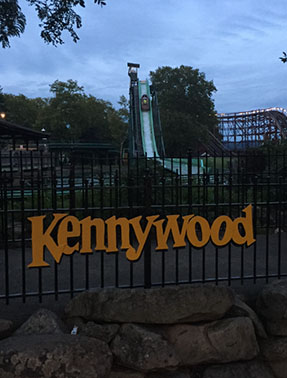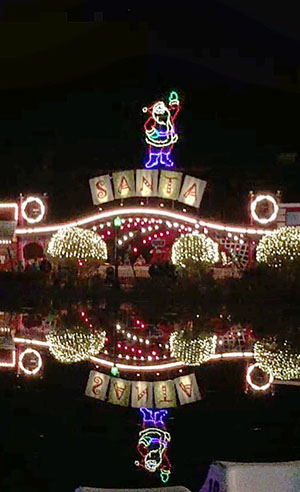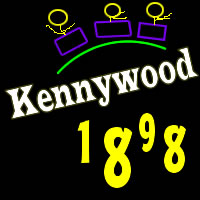

Connecting you to Kennywood Park closer than ever.
History
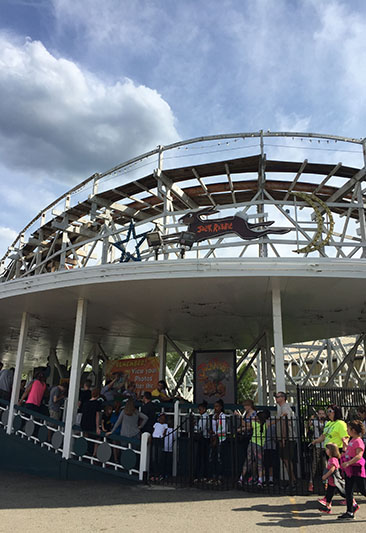 |
The Early Years (Foundations-1929)The famous tract of land overlooking the Monongahela River near the intersections of West Mifflin, Duquesne, and Homestead that is now home to Kennywood Park was inhabited prior to the Civil War by the Kenny family. In the years following the war, families began picnicking in the wooded area that became known as Kenny's Grove. In 1898, the Monongahela Street Railway Company leased the land to found a small "trolley park", which were quite common around the turn of the century. Andrew Mellon is credited with selecting the name "Kennywood". By 1906, Kennywood had already added several rides, including primitive roller coasters, a carousel, and the still-surviving Old Mill (1901). Also in 1906, three men bought the park. Descendants of two of these men, Frederick Henninger and Andrew McSwigan, operated the park for the next one-hundred years. As the nation entered the boom times that were the 1920's, Kennywood joined the country in prosperity. The decade began with the opening of Kennywood's oldest surviving roller coaster, the Jack Rabbit, in 1920. The Jack Rabbit has thrilled park guests ever since, most notably for its camel-back drop that remains unique in the coaster world today. In 1924, Kennywood added another roller coaster, the Pippin, and followed up with the addition of the park's second Racer in 1927, which survives today. Other major additions of the 1920's include the current Merry-Go-Round, the Turtle, Kiddieland, a giant swimming pool, and the Auto Race as the decade neared its conclusion. The park added many other assorted rides during this period.
|
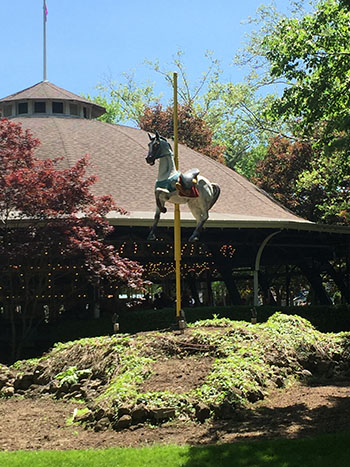 |
Survival (1929-1959)The 1930's, 1940's, and 1950's were difficult times for Kennywood as the park struggled to cope with global events. The Great Depression was especially hard on the park, as customers and supplies were often hard to find. Yet Kennywood was able to survive these challenges, and the 1936 addition of Noah's Ark signaled the end of hard times. The Ark has remained a Kennywood icon ever since, and is consecutively voted as the best fun house attraction in the world to this day. Kennywood thrived and even expanded during the years following the depression. The onset of World War II proved to be even more difficult for Kennywood than the Depression. Employees were hard to find as troops fought over seas, and supply shortages made ride repairs extremely difficult during this period. The nation's rationing of goods such as gasoline and tires was challenging for amusement parks as they were lowest on the priority list to receive supplies during the war. Many other local amusement parks were forced to close during this period, but Kennywood's prime location and the talent of its extraordinary mechanics allowed it to operate during the war. Growth resumed in the park following the war with numerous new amusements being introduced. Yet the 1950's presented another challenge to the park with the development of the television. With many people finding it easier to be entertained in the comfort of their homes rather than outside at an amusement park, Kennywood had to get innovative to attract the crowds. Television character appearances at the park was one method. Also, the park added Fall Fantasy parades during this period, with spectacular nightly displays and high school bands boosting attendance at the previously slow period at the end of each season. |
|
Expansion (1960-1999)In the 1960's and 1970's. expansion was full steam ahead at Kennywood as it attempted to compete with emerging super theme parks. In 1968, in one of the most monumental years of Kennywood Park history, Andrew Vettel, Sr. redesigned the Pippin roller coaster into the much more thrilling Thunderbolt. Utilizing the ravine section of the old ride, Vettel redesigned the middle section of the ride to include a series of tight helices and turns. A writer in the New York Times dubbed the ride as the "King of the Coasters", a name which attracted patrons to Kennywood from all over the country. By this point, the Henningers and McSwigans were finally able to purchase the land on which Kennywood was situated from the Kenny family, and were thus able to begin adding more permanent attractions. The Turnpike ride was a popular ride in which youngsters drove around a guided track, a ride similar to those being added at Kennywood's competitor theme parks. In 1975, Kennywood added its first million dollar ride, the Log Jammer. Both of these rides remained popular with families during their tenure at the park. In the 1980's, Kennywood looked toward the modern amusement industry. In 1980, Kennywood added its first steel roller coaster, the Laser Loop. This shuttle-loop coaster remained very popular with teenagers. Other famous rides added in this decade included the Gold Rusher, Pirate, Wave Swinger, and Raging Rapids. In 1982, Kennywood purchased Idlewild Park, a beautiful children's park located nearby. In 1989, Kennywood opened an entirely new park: Sandcastle Waterpark, located just a few minutes from the park. Additionally, Kennywood was given the great honor of a designated National Historic Landmark, and in 1988, Rick Sebak and WQED produced an award-winning documentary on the park entitled Kennywood Memories. Kennywood again moved toward the future while acknowledging the past in the 1990's. In 1991, the park removed the aging Laser Loop to make room for the record-breaking Steel Phantom, which opened as the world's tallest and fastest roller coaster. In 1995, Kennywood constructed the largest-ever single expansion of the park to date, Lost Kennywood. Lost Kennywood is modeled after other turn-of-the-century amusement parks gone by. Popular rides added during the 1990's included the Skycoaster, Pittsburg* Plunge (spelled in a nod to the turn-of-the-century), PittFall, and Exterminator. The park also celebrated its 100th anniversary season in 1998. |
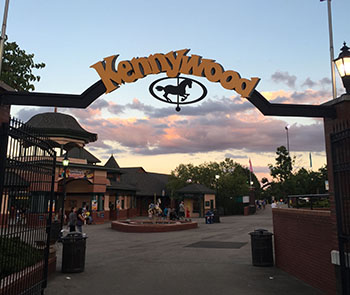 |
Modern Kennywood (2000-Present)Kennywood continued to add world-class thrills into the early 2000's. In 2001, the park removed the second half of the Steel Phantom and redeveloped the ride into the much more smooth, thrilling, and popular Phantom's Revenge. Other rides added during this period included the Aero 360, SwingShot, Cosmic Chaos, and Ghostwood Estate. Kennywood's operating season extended beyond Labor Day for the first time with the institution of the Phantom Fright Nights Halloween Event. Another landmark year for Kennywood occurred in 2007 when Kennywood was sold to Palace Entertainment. While the park was sold, it remained committed to moving toward the future while retaining its original historical identity. In 2010, the Sky Rocket LSM launched roller coaster debuted, with the Holiday Lights Christmastime event beginning in 2011 and the Black Widow added in 2012. The park remained successful through the 2010's. In 2017, Kennywood announced the removal of the aging Log Jammer to make room for future development. In 2018, Kennywood announced its second-largest single-season expansion to date, Thomas Town, bringing four new junior rides and the redevelopment of the area surrounding the park's historic tran ride. |
|
Post-Seasonal EventsBeginning with the advent of Phantom Fright Nights in 2002, Kennywood began extending its operating season past the traditional closing date of Labor Day. All of these events are historical for the park as they allowed it to grow and become not only a springtime and summertime destination but also a autumn and winter entity. Phantom Fright Nights (2002)In 2002, Kennywood opted to end the long-surviving tradition of closing for the season on Labor Day by adding the Phantom Fright Nights event. On Fridays and Saturdays in late September through October, the park opens during the night as a transformed Halloween extravaganza not for the faint of heart. The entire park is transformed into a haunted land filled with ghosts and ghouls that scare unsuspecting passerby. Summertime icons such as the Parkside Cafe, Penny Arcade, and Raging Rapids are transformed into haunted houses. A large selection of rides operate, including the park's roller coasters and thrill rides. For more information, click here. Holiday Lights (2011)Other post-seasonal events have since been added to further extend Kennywood's operating season. Holiday Lights debuted in 2011. The park opens Friday, Saturday, and Sunday nights in late November through December for Christmastime cheer. The entire park is decked out for the holidays, with millions of lights and decorations spread throughout the park. Holiday-themed food, activities, and even rides (yes, rides!) can be found during Holiday Lights. For more information, click here. Happy Hauntings (2017)In 2017, Kennywood extended its operating season once again to include Happy Hauntings, a kid-friendly Halloween event designed to accommodate children too young to experience the terror of Phantom Fright Nights. Happy Hauntings occurs Saturday and Sunday afternoons throughout October before the ghosts and ghouls from the unknown take over the park grounds after dark. Kid-friendly themed activities and rides operate for Happy Hauntings, including a hay ride through the park. For more information, click here. |
This website is not affiliated with Kennywood Park or Palace Entertainment. For complete details regarding the park, please click here.
UPCOMING EVENTS:
| May 27-28 | Ribs & Blues Festival |
| May 29-June 3 | Thunderbolt Week |
| June 3 | Kenny's Koaster Race |
